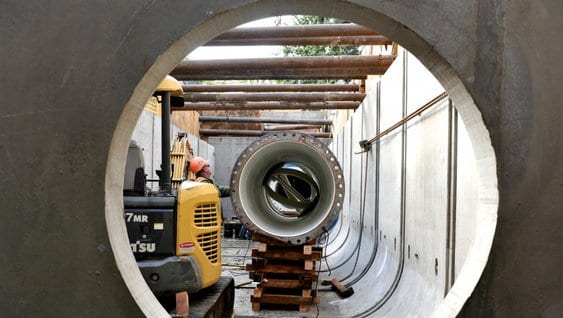It’s a renewable energy source, but hydropower has its pitfalls. Its dams can kill fish and other marine life and majorly disrupt habitat, and they can also end up emitting significant amounts of greenhouse gases — a side effect that many of hydro’s fellow renewable energy sources, including wind and solar, don’t share.
But there’s one place with near-constant running water that can be tapped for energy without causing environmental problems: cities’ drinking water pipes. LucidEnergy, a Portland, Oregon-based startup that launched in 2007, is starting to capture the energy of water pipes, beginning with a pilot project in Riverside, California and now with a full-scale project in Portland.
Gregg Semler, president and CEO of LucidEnergy, said his team originally went into the business of hydropower by looking at ways to capture energy from streams. But they soon realized that it was difficult to predict the flow of a stream, and that generating hydropower could be environmentally degrading. Pipes, on the other hand, are existing-man made infrastructure, so equipping them to be power producers doesn’t present any environmental concerns. They also pump water daily at a fairly constant rate, which allows for a consistent flow of energy.
“What’s really interesting about Lucid is this is a new source of energy that’s never really been tapped into before,” Semler said. “You take the best of hydroelectricity and put it in the pipe.”
The project touts itself as environmentally low-impact. But it could also help safeguard cities’ hydropower sources against drought, Laura Wisland, senior energy analyst for the Union of Concerned Scientists, said. In California, for instance, the historic four-year drought has lowered snowpack levels and depleted reservoirs, leading to a decline in hydropower production in the state. To account for this decline, the state shifted over to natural gas — a move that cost Californians $1.4 billion more for electricity between 2011 and 2014 than in typical years, according to a Pacific Institute report.
But even in a drought, cities work hard to keep drinking water running through the pipes, Wisland said — a fact that better insulates Lucid’s system against drought.
“We are less vulnerable to variations in the ability to generate this type of hydropower than we are with projects with large dams that need to be full,” she said. “I live in California, and we’re having a drought, and our ability to develop hydropower is much more limited than it has been in the past…I don’t think you’d see the same level of variability with this type of hydro power; there’s a more constant supply of power.”
LucidEnergy tested out the project in Riverside with funding from the Department of Energy. Semler said he targeted Riverside because he knew the city was “really progressive in terms of energy efficiency.”
“We went to them, and they liked the idea. It was a relationship right off the bat,” he said.
In Riverside, the electricity generated from the pipes is used to power street lights. Portland’s project has a bit more heft to it: it produces, according to Semler, an average of 1,100 megawatt-hours of electricity a year. That’s enough for about 150 homes.

The system is installed in 50 feet of Portland water pipes, in sections where the water flows downward due to gravity. There are four sections of pipe, and each has a generator on top and a 42-inch turbine that spins as the water flows inside. According to the company, up to four units of the so-called LucidPipe can be installed “in a standard 40-foot” section of water pipe, and one mile of 42-inch diameter pipeline has the potential to produce more than 3 megawatts of electricity.
In Portland, the turbines were installed by replacing a section of existing pipe with Lucid’s pipe, and bolting that new pipe to the existing water system in a process “sort of like Legos,” Semler said. But he also said there’s a market for the technology in cities that are building new networks of water pipes — cities that may have more need of water due to an influx of residents, for instance. In those cities, the new sections of pipe could incorporate Lucid technology.
A lot of cities around the world are dealing with aging infrastructure and facing questions about how to replace it, said Amy Nagy, business development coordinator at the Portland Development Commission, which worked with Lucid to get the project off the ground in Portland. As cities go through and make improvements to their infrastructure, she said, they could be looking into whether they could get a dual purpose out of it.
“Water pipes deliver clean water, and LucidPipe adds an additional benefit of clean energy production, and producing revenue that the city can go back and reinvest,” she said.

Semler is already looking at expanding the system to other cities. Johannesburg, South Africa announced earlier this year that it would be employing the technology in its water system. And Semler said he’s gotten interest from cities in China, Brazil, Canada, and Mexico. A city interested in LucidPipe must first agree to adopt the system, and then go about securing private capital. Portland’s project cost about $1.7 million, which was paid for by private investors. It’s expected to produce $2 million worth of energy over 20 years. The revenue generated from the energy goes partly to Portland, partly to Lucid, and partly to the third-party investor. Those private investor own the project in Portland, Semler said, so the system works similarly to solar panel leasing.
“The challenge in getting cities to agree to the project,” Semler said “is a lot of cities don’t have the capital to put in pipelines.”
Still, he said, he has high hopes for the idea.
“Mostly what cities do is they try to keep infrastructure viable. We see LucidPipe as a tool that water agencies can use to bring private capital into building out new water infrastructure projects, or to reduce operating costs,” he said. “There’s been a lot of investment over the last 10 years in solar, wind, and biogas — we see same thing happening with our product.”
If cities can get ahold of the capital, the LucidPipe system could spread. Wisland said she thinks the idea has “tremendous potential” and said that, in general, the idea was “a no-brainer.”
“It’s not going to be generating as much power as a large scale solar farm,” she said, “but its part of a growing trend of taking advantage of existing infrasturcture. We have water pipes all over the country, so I think it just makes sense.”
Wisland said that one barrier that could prevent the system from being used in all water pipes is the fact that, with hydropower, there needs to be some pressure to move the water. So the pipes would be best used in gravity-fed systems, or other systems where there’s a possibility to create a little pressure.
Wisland also pointed to the environmental benefits of the system. Any time a hydroelectric system is put in a place that isn’t the natural environment, it avoids the damage caused to ecosystems and the organisms that live in them. Still, hydropower makes up about 6 percent of the U.S.’s electricity generation — almost as much as all other renewables combined — and if there are ways to increase that percentage without posing harm to the environment or increasing greenhouse gas emissions, it makes sense to take advantage of those methods.
“Hydropower is an extremely important part of our existing electricity portfolio and will continue to be so,” Wisland said. “Most people think the era of large dam building in the U.S. is over — we really do need to be turning our efforts over to ways to improving efficiency and finding more creative, non-traditional ways to generate hydropower electricity. As we think about reducing emissions in electricity sector, we can’t take hydro off the table.”
Source: Climate Progress. Reproduced with permission.











